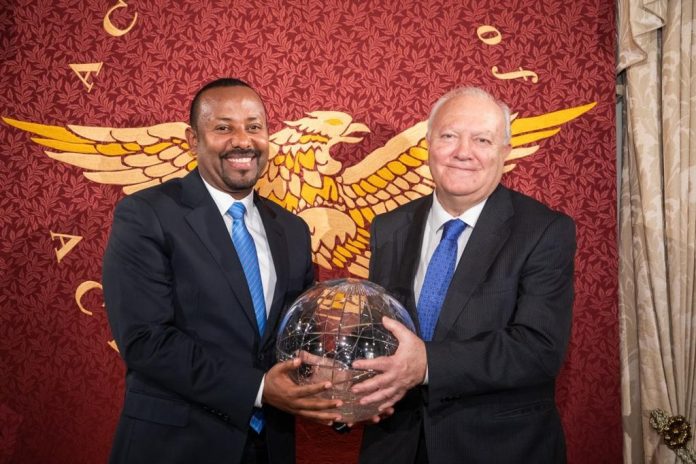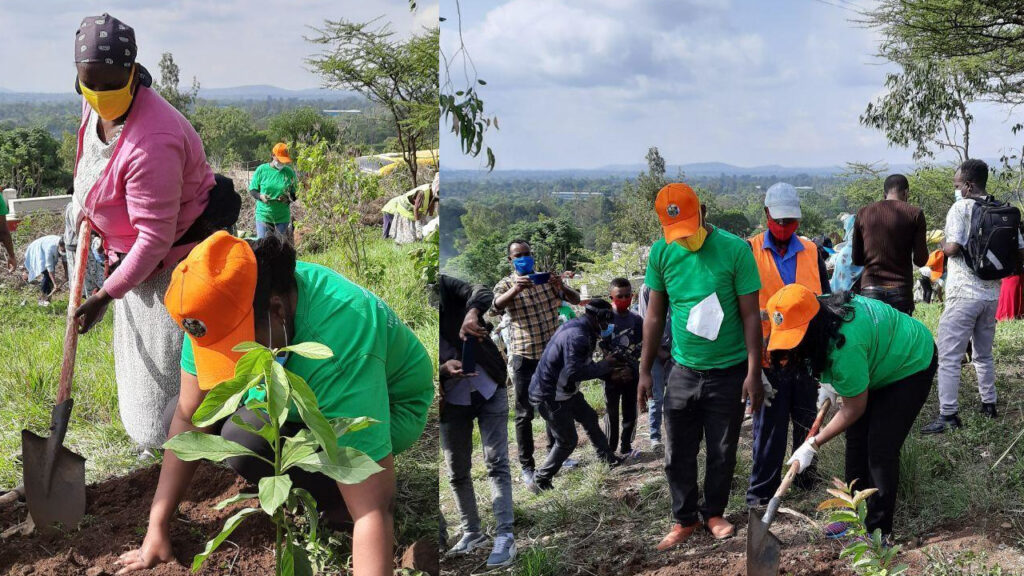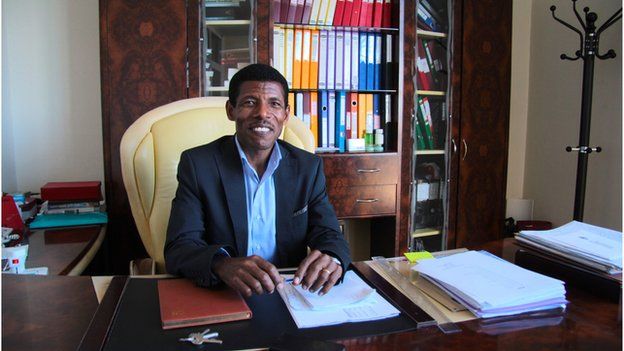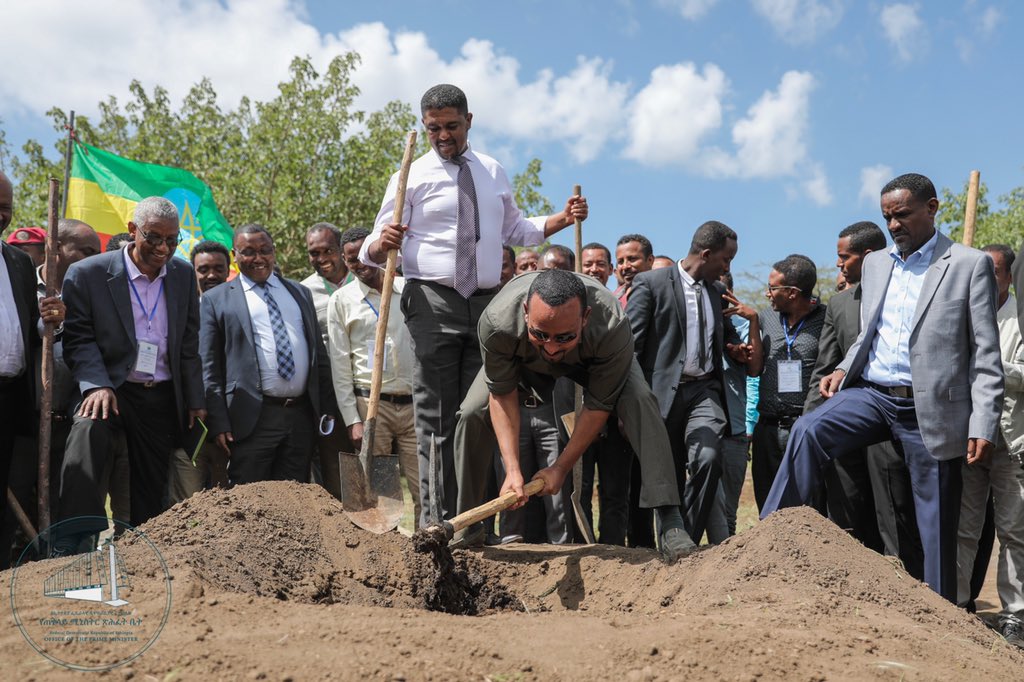
Ethiopia’s Prime Minister Ahmed Abiy was last week recognised for his Green Legacy Initiative, an environment protection program.
It happened in the USA on the sidelines of the US – Africa Summit at a special event under the theme “Africa: The Urgency of a Global Mobilization” in Washington DC. Prime Minister Abiy was given the ‘Outstanding African Leadership Award’ for his Green Legacy Initiative.
In his acceptance speech, Prime Minister Abiy thanked the organisers for shining the spotlight on Africa’s ability to solve her own problems.
“Indeed, our continent is filled with many success stories – past, present, and future. The perspective that African countries are net producers of problems that always require external assistance is an outdated one,” he said before adding, “Therefore, great appreciation to the organizers for lighting a torch on the continent’s net production of solutions.”

It should be recalled that Ethiopia launched the Green Legacy Initiative in 2019 with an ambition of planting 20 billion seedlings in a span of four years and exceeded the set goal by fulfilling the four year challenge with 25 billion seedlings planted throughout the country.
“Four years into the implementation of the Green Legacy Initiative,” PM Abiy continued, “we have mobilized 25 million Ethiopians across the nation to plant 25 billion seedlings, equivalent to 250 seedlings per Ethiopian. The impact could be equated to removing 64 million gasoline-powered cars from the roads for a whole year.”
He added that Ethiopia’s Green Legacy Initiative “is the most extensive afforestation and reforestation program next to the Amazon.”
HISTORIC BACKGROUND
Planting trees and environmental protection is rooted in Ethiopia’s history. The country has undertaken various afforestation programs consisting of 162 establishing tree plantations where there were no prior indications of forest cover. The 163 Emperor Menelik II (1889–1913) pioneered the use of Eucalyptus globulus introduced from 164 Australia to alleviate the shortage of construction and fuelwood in the Ethiopian capital, 165 Addis Ababa.
The Derg regime (i.e., the Provisional Military Government of Ethiopia, 1974–166 1991) implemented strict rules on forest protection and management, along with a massive 167 afforestation campaign across the country.
The 180 earliest nation-wide forest cover data for Ethiopia was collected only in 2000, and it suggests 181 that both forest and woodland covered 12% of the country
The Green Legacy Initiative – Initiated by PM Abiy Ahmed – The Ethiopian government has consistently made global headlines with ambitious tree planting targets, since launching its Green Legacy Initiative (GLI) in 2019 – which seeks to plant 20 billion trees with in four years until 2022. Among African countries, Ethiopia has shown strong political will for tree planting by 616 pledging 15% of the continent-wide AFR100 targets.
ROLE OF COMMUNITIES

The Ethiopian government excels in designing massive initiatives involving community mobilization such as the Green Legacy Initiative, which enjoys strong social and government support.
The Contribution of the Defense force to the green Legacy initiative is quite excessive.
MASSIVE CAMPAIGNS
To send a message to ordinary people, famous figures have embraced the campaign, people like Like Ethiopian athlete and successful businessman Haile Gebreselassie,
This year’s planting season represents the final round of the initiative, but supporters say there’s a clear need to keep going.

“We have no alternative except to continue having such an initiative at a larger scale,” said the in an interview with the Ethiopian News Agency in July 2022. “We know even European countries are paying the price for destruction of natural forests.” Gebreselassie also shared his personal aspirations to support this process: “I have a keen interest to cover a bare mountain with forest, covering its full cost,” he said.
ACHIEVEMENTS
Beyond simply getting trees in the ground, the GLI has achieved several notable successes in building capacity, systems, and culture around restoration.
According to a statement that the Prime Minster’s Office released on 15 August 2022, the number of nurseries in the country has increased over three-fold – from less than 40,000 in 2019, to 121,000 in 2022. The initiative has directly created 767,000 green jobs – mostly for women and youth – in the past four years. It has also contributed to much more widespread awareness of the importance of reforestation. “While much still remains, there is no shred of doubt that the Green Legacy has delivered results, the most important of which is ‘green culture,” read the statement from the Prime Minister’s office.

“We have no doubt that this new culture will be a legacy preserved for Ethiopia’s future generations,” the statement continued. “Many cities throughout the country are now being conscious of the need to nurture green spaces and enhance forest cover in conducive areas. We could not have been able to ignite this consciousness amidst the fast-paced urbanization without the commitment of millions of citizens for whom service of the nation has been of paramount importance.”
Economic benefits of tree planting in Ethiopia, are expected to show through production of timber and other by products. It is an important driver for local communities to invest and participate in tree planting.

